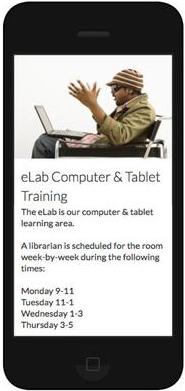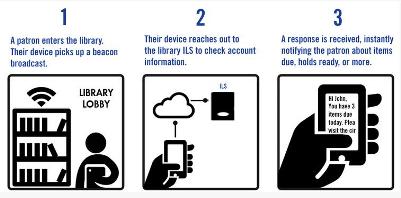“Beacon” Technology Deployed by Two Library App Makers
Library app developers Capira Technologies and BluuBeam have separately announced the launch of micro location information services that will enable libraries to send highly targeted, location-relevant messages to Bluetooth-enabled Android and iOS smartphones.

BluuBeam can send messages regarding upcoming computer training courses
“For instance, in the café, daily specials; in the children’s area, what’s happening there that day; in the Fab Lab, things that have been made,” said FFL Executive Director Sue Considine. “We felt like every flyer that we produce, every message that we put up on digital signage, should also be available without a mediator necessary, through BluuBeam, to people who come through the door.” Patrons can then easily save information that they are interested in, or forward a message to a friend. “What we experience frequently here at FFL—and why this is such a great fit for us—is that we have high volume, high quality programming all the time, yet we get constant feedback from patrons saying, ‘I didn’t know about that.' Or, 'I didn’t hear about that,’” despite the library’s outreach efforts via newsletters, social media, its website, and other means, Considine said. BluuBeam founder Chris Zabaleta added that giving library users an easy way to forward this info to their friends can also help a library expand its marketing effort to non-library users within the community. “If [libraries are] putting this information on their Facebook page, or they’re Tweeting about it or posting it on their website, if I’m not [regularly] using the library, I’m never going to see it,” Zabaleta explains. “But if a friend of mine is using the library, and they send me a beam about a class or event that might interest me, that could compel me to go to the library and start using it.”Patron specific
Separately, Capira Technologies is currently working with two libraries to beta test a new beacon feature for the company’s own customized CapiraMobile app for libraries. Capira’s beacons will offer general notifications, and since CapiraMobile is already designed to communicate with a library’s ILS in order to support functions such as self checkout and patron record notifications, its beacons will also be able to send personalized messages to individual patrons when they are in range.
CapiraMobile's beacons can help an ILS send personalized messages to individual patrons
“If someone walks in to the library, it will check whether [he or she has] the app on [his or her] phone, then it will go out and check the patron record for certain things and say, ‘Hello, you have two items due today. Visit the circ desk to renew them.' Or, 'You have two items ready for pickup,'" explained Michael Berse, managing member and lead software engineer for Capira. CapiraMobile also integrates with many event calendar platforms, which will enable automated beacon updating whenever these calendars are changed, Berse said. Richard W. Loomis Jr., digital services manager for New Jersey’s Somerset County Library System (SCLS), had been experimenting with ways in which an iBeacon might work with a Raspberry Pi when Berse approached him about working on an iBeacon beta test with Capira. Initially, SCLS plans to use individual beacons near branch entrances to test patron record notifications. But Loomis was enthusiastic about other potential uses as well. In addition to event notifications, the beacons could be used to send patrons information regarding nearby historic photographs or artifacts within a library, for example. And, if SCLS partners with a local business or transit agency willing to host a beacon at shops or train stations, library event notifications and marketing messages could be broadcast farther afield, Loomis said. “Our marketing department has a million ideas,” he said.On message
Patrons must actively choose to receive messages from either service. In BluuBeam’s case, patrons will need to download the free app from the iTunes or Google Play store. With CapiraMobile, patrons may already have their library’s app installed on their phones, but after applying an update they will be prompted to opt in or opt out of the beacon service. Unlike Apple iBeacon, or Samsung’s new “Proximity” branded Bluetooth beacons and apps for Android devices, users will not receive messages in retail environments once they have installed or enabled these apps. Loomis said he was conscious of spamming concerns. “It needs to be an opt-in service,” Loomis said. “It can’t be something where [the beacon notifications are] more spam, more garbage coming at someone. If they want to know about it, we’re going to do it.” Both the CapiraMobile and the BluuBeam systems can be set up to send each new notification to a unique device only once, so patrons won’t be bombarded with multiple, redundant notifications while browsing their library. Still, Ellen Druda, digital projects coordinator, Internet services, for Capira’s other beta tester, the Half Hollow Hills Community Library (HHHCL) in Long Island, NY, said that she conscious of the spam factor as well. “We don’t want to spend time getting this done and then have people opt out immediately,” because the messaging is too frequent or isn’t fulfilling a patron’s needs, she explained. Loomis noted that SCLS may even consider subdividing their beacons into different classifications, to make messages even more targeted. In this scenario, parents could opt in to notifications about events for children exclusively, while a young adult might choose only to receive messages about computer training events, for example.Privacy protections
Patron privacy may be another point of concern for librarians and some patrons. Currently, BluuBeam works with a simple online portal that enables libraries to update messages for each of their beacons and set other protocols when needed. The BluuBeam system does not communicate with a library’s ILS, event calendar, or other software. A beacon does capture the Unique Device Identifier of each Bluetooth device that it interacts with, enabling it to track how many devices have been “pinged” with each message and whether that device then shared the message via text or email, and to prevent it from sending duplicate messages to the same device multiple times. However, Zabaleta said that BluuBeam does not retain Unique Device Identifier numbers. Neither his company, as an app developer, nor the library using the system, will have access to any personally identifiable information regarding patrons that have downloaded the app—such as a log of times that a patron visited a library, or where they browsed or sat. The beacon “only knows whether it’s a different phone, or if it’s a phone that it has already seen,” he said. “It’s a feature that Apple and Android both have built into them…. They scramble that information.” By contrast, the CapiraMobile app is already integrated with many ILS systems and event calendar platforms. This enables more functionality, such as notifications sent to specific patrons regarding items coming due or holds available for pickup. Aware that some patrons may be concerned about having a third-party app retrieve and transfer that information, Berse said that Capira had a legal team write a privacy policy that will explain exactly how patron information is being handled. And, he emphasized that a patron can still use all of the app's other functions if he or she chooses to opt out of the iBeacon feature. “Even if tracking is anonymous, there are people who don’t want to be involved,” Berse noted. “We want them to be able to opt out.” Regardless, Druda said that HHHCL is excited about the outreach potential of the beacons, and said that staff will be encouraging patrons to download the app and opt into the service. Unlike predecessors such as QR codes and near-field communication (NFC) apps, once patrons opt in, they won’t need to do anything else to receive these messages. “The only thing it will require on the patrons' part is to have our app and to have their device on them,” Druda said. “We’re hopeful that this is going to be a good experience for [patrons] and give them some good information without being too in-your-face.” BluuBeam devices are available for $150 each, and come with a one-year license to use the company’s online portal/admin panel to update the messages for each beam. CapiraMobile’s iBeacons will be available as an add-on feature for CapiraMobile libraries beginning early in Q1 2015.Add Comment :-
RELATED
RECOMMENDED
TECHNOLOGY
ALREADY A SUBSCRIBER? LOG IN
We are currently offering this content for free. Sign up now to activate your personal profile, where you can save articles for future viewing









